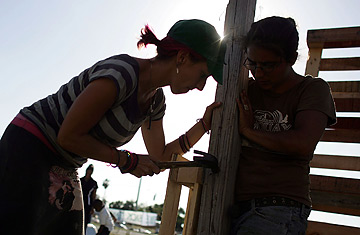
Makeshift structures have been erected as shelter for homeless people on a vacant lot in Liberty City, a neighborhood in Miami.
The Umoja shantytown, named for the Swahili word for unity, is hardly one of Miami's hottest real estate listings — but there's a waiting list to live there. That demand is a disheartening indication of the city's grave low-income housing crisis, a nagging civic sore thumb as Miami prepares to host the Super Bowl next month. Activists chose the Liberty City site for the makeshift shantytown, because it's where a condemned housing project was razed in 1998 with the promise that more and improved low-income homes would be built there for some 500 residents. That never happened, even though Miami-Dade County allocated $8.5 million that was scandalously squandered on architects, consultants and other overhead. "The county is stealing, the city is not rebuilding, what are we supposed to do?" asks Max Rameau, head of Take Back the Land, a group that organized the Umoja shantytown, which opened last October. "We wouldn't be able to get away with this if the government wasn't involved in corruption and there were viable alternatives."
But as the Feb. 4 Super Bowl approaches, city officials are scrambling to find a way to make the shantytown disappear. "We have to have a more aggressive plan to have housing to meet their needs," Miami City Manager Pete Hernandez concedes, "but at this point they are overstaying their welcome." Under a unique 1998 legal settlement with all of Miami's homeless, the Umoja occupants are protected from arrest; and an emergency, legal-loophole ordinance introduced by the city attorney last month to eradicate the shantytown was pulled after a public outcry. Instead, the city is offering shantytown occupants beds in various programs and shelters — but only 10 have accepted, and other homeless are simply taking their place.
That's hardly a surprise. More than 40,000 Miami residents, whose salaries in the city's low-wage service economy can't keep pace with its high rents, are awaiting affordable housing — even as more than 40,000 ritzy condominium units are going up in the revitalized downtown area near a luxurious new performing arts center.
Miami, in fact, is the nation's least affordable city: even in Liberty City, it's hard to find a private home for less than $195,000, more than 10 times the average income of the district's 26,000 residents. As a result, shantytown organizers like Rameau insist they'll stay at it, training the Umoja residents how to run the village and coordinating social services for them; Rameau says he has other potential sites in mind for additional shantytowns, but no firm plans as of yet. The need is certainly still there. Jonathon Baker, 33, who used to run a martial arts studio before hitting hard times and homelessness, now has a full-time job, but he says he'll stay in the shantytown until he can find affordable housing. "If the system in place for housing was working," he says, "I wouldn't be here."
